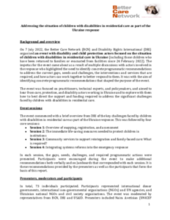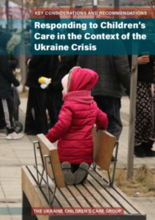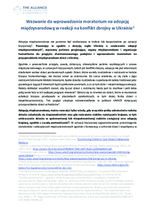This country page features an interactive, icon-based data dashboard providing a national-level overview of the status of children’s care and care reform efforts (a “Country Care Snapshot”), along with a list of resources and organizations in the country.
demographic_data
childrens_living_arrangement
children_living_without_bio
key_stakeholders
Key Stakeholders
Add New Datadrivers_of_institutionalisation
Drivers of Institutionaliziation
Add New Datakey_research_and_information
Key Data Sources
Add New DataCall to Action: Building a rights-based child protection system in Ukraine, free from institutions
Country Care Review: Ukraine
Prevalence and number of children living in institutional care: global, regional, and country estimates
Displaying 121 - 130 of 367
Vasyl Velychko has been tied to a bench on a baking hot day for hours, but no-one hearing his screams will untie him. The 18-year-old is one of thousands of disabled people living in Ukraine's orphanages. BBC News has gained access to five institutions and found widespread abuse and mistreatment - including teenagers restrained and adults left lying in cots for years.
Ukrainians fleeing war in their homeland found open arms across the West. But for many, reaching the United States proved to be an arduous journey charged by border politics.
Some, like Maxim Blyzniuk and Oksana Ilchishena arrived in Mexico and made it across the border with their families into the United States, only to encounter hardship on the other side. Others, like Inna Dunai, a mother of five, flew across an ocean only to find the U.S. border shut — leaving them trapped in an unfamiliar foreign country, confused and disillusioned.
"The kids here need more attention. We need staff, staff, staff." This is the plea from Mykhailo Zaidel, the director of an Ukrainian orphanage which is struggling to cope after the war sent it an influx of children. The Magala orphanage was caring for 10 children with learning disabilities before Russia invaded on 24 February. It is around 1,000 miles from the frontline but the war has cast a long shadow.
Children should be at the heart of any humanitarian or other assistance for Ukraine. Particular attention must be paid to the most vulnerable groups of children who are unaccompanied, separated from their families, disabled or from children’s institutions. Unfortunately, to this day, the international community has not identified a comprehensive action plan on how to address the dire situation of these children. The speakers will explain the current situation of children in Ukraine, the gaps and solutions that support the most vulnerable groups of children.
US Secretary of State Antony Blinken has called on Russia to stop forced deportations and "filtration" operations involving Ukrainians. Russia had detained and forcibly moved to Russia some 900,000 to 1.6 million people, many of them children, he said.
More than a quarter of Ukrainians – 12 million – have been forced to leave their homes. While about seven million are internally displaced, five million have sought asylum in neighbouring European countries, the UNHCR says. And throughout the war, observers have been noting a double standard in the treatment of refugees. While those from other conflict-hit nations are shunned by Western countries, Ukrainians fleeing war have been welcomed with open arms.
On 7 July 2022, the Better Care Network (BCN) and Disability Rights International (DRI) organised an event with disability and child protection actors focused on the situation of children with disabilities in residential care in Ukraine (including those children who have been returned to families or evacuated from facilities since 24 February 2022).
The aim of this guidance document is to provide a framework to support child protection practitioners and policymakers working both inside Ukraine and in host countries to implement responses related to children’s care in the context of Ukraine in line with international standards and good practice on children’s care and the provision of alternative care.
Russian forces have reportedly captured the teenaged son of an official in Zaporizhzhia, while others have been separated from their families.
Adopcja międzynarodowa nie powinna być realizowana w trakcie lub bezpośrednio po sytuacji kryzysowej. Pozostając w zgodzie z decyzją rządu Ukrainy o zawieszeniu adopcji międzynarodowych, wzywamy państwa przyjmujące, organy międzynarodowe i organizacje humanitarne do przyjęcia zharmonizowanego podejścia i wprowadzenia moratorium na przysposobienie międzynarodowe dzieci z Ukrainy. Zgodnie z powszechnie przyjętą zasadą dotyczącą obowiązków państw wynikających z prawa międzynarodowego, w sytuacjach kryzysowych, takich jak konflikt zbrojny, adopcja nie jest właściwym działaniem wobec dzieci pozbawionych opieki. Dzieci, które zostały rozdzielone z rodzicami w trakcie kryzysu humanitarnego, nie można uznać za osierocone. Do czasu ustalenia, co się stało z jego rodzicami lub innymi bliskimi krewnymi, każde dziecko rozdzielone z opiekunami należy traktować jako posiadające żyjących krewnych bądź opiekunów prawnych, a co za tym idzie – niepotrzebujące adopcji.




